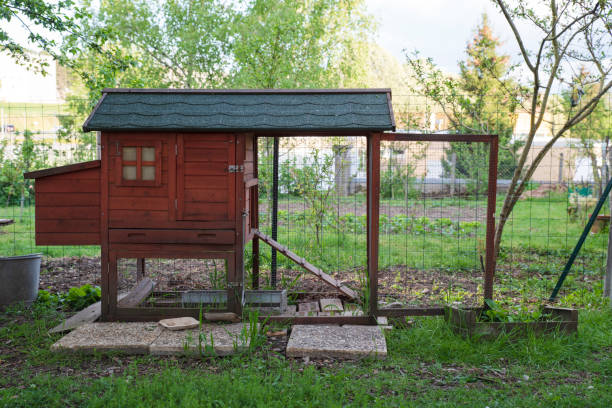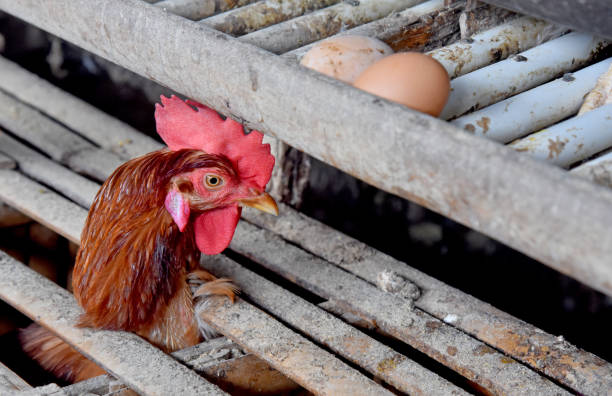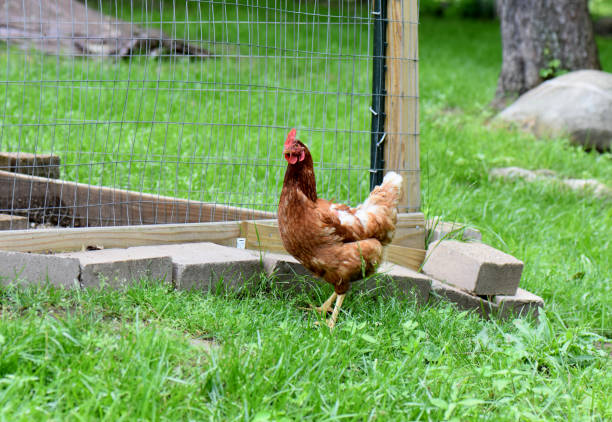Introduction
Having chickens can be one of the most fulfilling pastimes if the given units are appreciated in their raw form as they offer eggs, natural insect repellents, amusement, &c. However, the safety and security of these lovely birds or ‘feathered friends!’ as they may be referred to, cannot be overemphasized. Here, in this ultimate guide, we will look into the details on how best to provide protection to your chickens from and different kinds of predators and other physical hazards.
Understanding Chicken Runs
What is a Chicken Run?
Chicken run is an open field that is designated to allow the chickens wander, feed and exercise in the open air but close from different dangers. It is preferably connected to a chicken house but may also serve independently of a chicken house. To fully guarantee the health of your birds and ensure they lay well, a good design of a chicken run cannot be overemphasized.
What is the story of Chicken Run?
‘Chicken Run’ is another animated film created with the use of stop-motion technique, which tells the story of the group of chickens of the farm owned by the evil Mrs. Tweedy. The protagonist is Ginger, a chicken who is very intelligent and who wants to liberate the other poultry and chickens from the farm where the mood is always dark as the chickens may be turned into chicken pot pies at any one time.
The motion picture opens with Ginger’s failed attempts to flea from the farm, and every try she makes is always foiled by the security system in the farm and Mrs. Tweedy. The rest of the chickens do not believe initially that she will be able to escape they get influenced by her spirit however. One day a rooster named Rocky shows up at the farm and insists on being flown. This Ginger perceives as an opportunity to free the chickens because she thinks that if they are able to fly they will be able to avoid the farm permanently.
Ginger and Rocky partnership the two are chickens and they mobilized other chickens and they construct an aircraft with a view of flying. During this process, the chickens experience lots of problems in their endeavor to escape – the farm owner, Mrs. Tweedy, becomes more cautious and her aim is to transform the farm for large-scale industrial production of chickens.
In the story, there are clear transformations in the chickens, which become more muscular and perseverant in their fight for liberation. Chickens and the inhabitants go on the offensive in great scene comprising of actions and comedy at the end the chickens hatch their escape plan. Finally they are able to cope with all these adversities and escape from the farm finally attaining theirapache casino greed desire for freedom.
Importance of a Secure Chicken Run
She pointed out that chicken is at the risk of several factors of insecurity some of which include; raccoons, foxes, hawks and even domestic animals. A covered chicken coop shields your birds from these risks and at the same time give the birds a chance to roam. In addition, by having a secure run, chickens cannot wonder off and get lost or injured and that in itself is a good reason to have one.
Is Chicken Run based on The Great Escape?
Yes, it can be stated that “Chicken Run” is based on war movies more specifically on “The Great Escape. ” The movie came out in the year 2000 and is a computer animated movie made with clay characters and animation style.
In ‘Chicken Run’ the major focal characters are the chickens, whose objective is to escape from a ‘farming’ facility where all hens who laid eggs were meant for being turned into pies. The techniques that have been used in this film can be connected with the main themes of the movie, ‘The Great Escape’ – the prisoners of the Second World War plan their escape from a German camp of prisoners of war.
They are alike in the aspect of portraying friendship among the characters, the wits that they use in order to deceive their captors, and the general theme of lening captivity. ‘Chicken Run’ takes these elements and then adds them to produce a comical, childlike, family-oriented picture out of the serious tone of war escape movies, as far as any viewer of the movie would understand.
Designing Your Chicken Run

Size Considerations
The initial consideration when planning for the construction of the chicken run is always the size of the run. In any case, a minimum of 10 sq. ft. per bird should be allocated on the inside of the run. Additional space is always welcome and will result in the chickens being able to display their natural behavior, interact with each other and thus have a lower stress level.
Location, Location, Location
Selecting the right location for your chicken run is essential. Choose a spot that offers:
- Sunshine and Shade: Chickens need sunlight for vitamin D synthesis but also require shaded areas to escape the heat.
- Well-Drained Ground: Avoid areas that tend to collect water to prevent muddy conditions that could harm the chickens’ feet.
- Accessibility: Ensure that the run is easily accessible for regular maintenance and egg collection.
Materials for Building Chicken Runs

The Frame
The frame of your chicken run can be constructed from:
- Wood: Treated lumber is sturdy and often the easiest to work with.
- Metal: Galvanized steel or welded wire is more resistant to pests and weather conditions.
- PVC Pipe: Lightweight and cost-effective for smaller runs but may not be as durable.
Fencing
The fencing you choose is critical for security. Options include:
- Hardware Cloth: A strong, welded wire that is more predator-resistant than chicken wire.
- Chain Link: Provides good visibility and strength but can be expensive.
- Electric Fencing: Offers an additional layer of protection, especially against larger predators.
Roofing
Consider adding a roof to your run to protect your chickens from aerial predators and adverse weather. Options may include:
- Wire Mesh: Keeps out birds of prey while allowing sunlight in.
- Solid Roofing Materials: Options like plywood or metal sheeting provide complete protection but reduce natural light.
Securing the Ground
Burying the Fencing
Predators can dig under fences to gain access to your chickens. To prevent this, bury the fencing at least 12 inches deep or create an L-shaped barrier buried horizontally outwards from the base of the fence.
Using Barriers
In addition to burying fencing, consider using:
- Rocks or Concrete Blocks: Placing these around the perimeter can deter digging.
- Garden Edging: Create a border around the run to help keep predators at bay.
Enhancing Security with Technology
Cameras
Installing security cameras around your chicken run can provide real-time monitoring and peace of mind. Look for:
- Night Vision Capability: Many predators are nocturnal, so nighttime surveillance is crucial.
- Wireless Options: For simpler installation and flexibility.
Motion Sensors
Using motion sensor lights or alarms can deter nocturnal predators. Consider installing:
- Spotlights: Bright lights that activate on movement.
- Alarms: Loud sounds that can scare off intruders.
Daily Maintenance and Safety Checks

Inspecting for Weaknesses
Conduct daily checks on your chicken run for signs of wear and potential breaches. Look for:
- Loose Fencing: Tighten or repair any loose areas immediately.
- Holes or Gaps: Fill in any holes that may have appeared over time.
Cleaning the Run
A clean chicken run is essential for maintaining your flock’s health. Regularly remove waste, feathers, and food scraps to prevent disease and pests.
Fostering a Safe Environment
Providing Hiding Spots
Chickens feel safer when they have places to hide. Consider incorporating:
- Bushes or Shrubs: These provide natural cover.
- Structures: Adding simple shelters or perches inside the run can give chickens a place to retreat if they feel threatened.
Socialization and Behavior
Understanding chicken socialization and behavior is crucial for creating a secure and nurturing environment in your chicken run. Chickens are social animals that thrive when they can interact with each other, engage in natural behaviors, and explore their surroundings. Here’s a comprehensive look at these aspects:
The Social Nature of Chickens
Much to my surprise, chickens are quite social animals. They are flock animals, therefore these animals group up for safety reasons and also for interaction.
-
Flock Hierarchy:
- Poultry in particular, chicken prepare what is commonly known as a ‘pecking order ‘which determines who has the right of way to food, shelter or mates. It is in this belief that the present work will provide an understanding of this structure with the aim of avoiding conflict and stress in your flock.
- Replacement of some or all the birds in a flock can only be done under operational control to reduce stress and aggression. Cautious acclimatization techniques are suggested; the most well-known of these procedures is called “chicken babysitting. ”
-
Communication:
- The form of communication that has been observed in this strand is vocalization, gestures, and posture, and behavior. Vocalizations have different meanings and can point at hunger, distress signals and the likely presence of a predator. Knowing these signals makes it possible for you to assess the welfare of your birds as well as their general wellbeing.
- For example, the loud vocalization which is called ‘alarm call’ is associated with danger, whereas more quiet sounds, the ‘clucks’, may be related to such feelings as comfort or satisfaction.
Natural Behaviors
All natural behaviors are important for the birds’ welfare and need to be allowed as much as possible for the chickens kept. Here are some key behaviors to foster:Here are some key behaviors to foster:
-
Foraging:
- Cooking has it that chickens are endowed with a natural ability to search for and scavenge food. To cater for their physical needs, they should be provided with a secure run that will contain areas where they can scratch, peck and dig.
- Sprinkle meal, seeds, or treats in the run or hide foraging toys to make then look for food in a natural way.
-
Dust Bathing:
- This is especially used by birds since it enables them to clean the feathers and minimize cases of parasites. Make sure your chickens have the loose dirt or sand in their area in order to prevent overgrowth of floor by droppings .
- By making sure that there is a specific area where the chickens can dust bathe, you will be promoting such a behavior and therefore happy and healthy chickens.
-
Roosting:
- Chicken has the natural ability to roost off the ground at night so as be safe. They always require good and adequate spaces to perch comfortably and safely in the coop.
- It is also important to make the roosting bars higher than any other construction in the pens to enable the birds roost comfortably at night.
- Nesting:
- Design a safe environment for hens that would ensure safe laying of their eggs. The nature of building used for raising birds should also entail nesting boxes’ construction that has straw or hay on it to help in encouraging on egg laying and also ease stress among the birds.
Enrichment and Interaction
In addition to providing space, it’s essential to create an enriching environment for your chickens that supports positive socialization and behavior.
-
Physical Enrichment:
- Introduce items like perches, ramps, and obstacles that encourage climbing and exploring. This will keep your chickens physically active and mentally engaged.
- Adding toys like hanging cabbage or treat dispensers can provide stimulation and combat boredom.
-
Social Interaction:
- Allow time for your chickens to interact with one another in a safe environment. Monitor interactions between different age groups or when introducing new chickens to minimize aggression and reduce stress.
- Observe your chickens to ensure they are forming bonds. Encourage social behaviors by allowing space for groups to gather and interact.
-
Safe Spaces:
- Make sure that the chickens have a variety of places to hide, or shelters they can go to if necessary in the chicken run. This could be as basic as a small shed or underground definitely areas made of logs or hay bales.
Recognizing Stress and Conflict

One must know that there are often such situations as stressed or conflicted all flocks experience from environmental challenges and social hierarchies.
-
Aggressive Behaviors:
- Some of the behavioral changes you should look out for include the incidences of pecking or bullying which are ugly behaviors that can lead to a situation where some birds get injured or stressed. Aim at arranging the space and resources in such a way that one chicken will not have a chance to compete with or fight the other.
- Avoid setting up multiple feeding and drinking points but instead, establish different feeding and drinking points so that none of the chickens will fight for food or water.
-
Signs of Distress:
- Chickens also stress in several manners and some of the common signs include, aggressive squawking, feather-picking and lack of energy. To investigate new problems that may be arising within your flock, it is wise to constantly observe the behavior of your flock.
- Chickens may chase each other, peck one another or show signs of stress – where this is observed, relocate the affected chickens to cool off.
-
Providing Support:
- This means that if you are introducing new chicks or going through changes such as combining different layers organizations need to have measures they will be taking to supervise and assist the chickens in this transition period. Offer more areas that the children can go and get out of the way of the bully or just comfort zones when the pressure gets more than they can handle.
Conclusion
FAQs About Chicken Runs
1. How often should I clean my chicken run?
Recommended practice is that the chicken run should be cleaned not less than once a week. Clean frequently, although droppings, unconsumed food, and anything else should be cleared away immediately. This reduces pile up of deleterious bacteria and parasites in the human body.
2. What size run do I need for my chickens?
A basic recommended standard for the space allocated to the chickens in the run is about ten square feet per chicken. More space allows the birds to get back to their natural instincts and also helps in cutting down on stress in your flock.
3. Can chickens be kept in a run all day?
Chickens will be happy to live in a run all day but they need to be provided with a chance to free-range when possible. Swapping their access to another area to maintain the novelty of the environment so as to encourage foraging activities among them.
4. What predators should I be most concerned about?
Raccoons, foxes, hawks and domestic dogs are among the most common causes of death in the species. The particular hazards will hence depend on your geographical location; you should identify our potential wildlife and ensure you take the necessary measures against them.
5. How can I deter raccoons from my chicken run?
Raccoons are smart animals that do not give up when searching for some food. To discourage them, make sure your run is well fenced and perhaps, include the use of locks on your coop. Additional measures one can take include having an electric fencing around the perimeter of the compound.
6. Should I cover my chicken run?
Yes, using wire mesh or solid roofing over the chicken run area will prevent birds of prey from swooping in to grab your chickens while the solid roofing will also shield the chickens from the scorching sun or from becoming a human target during a rain volley.



